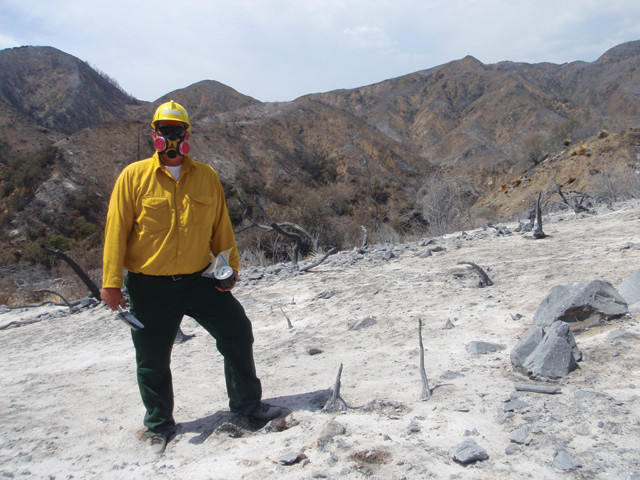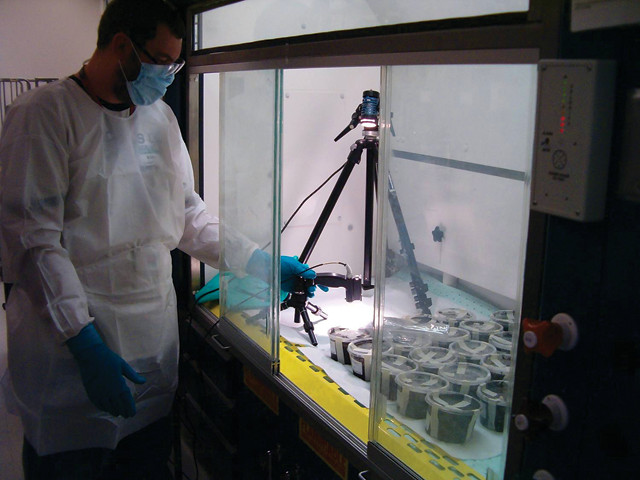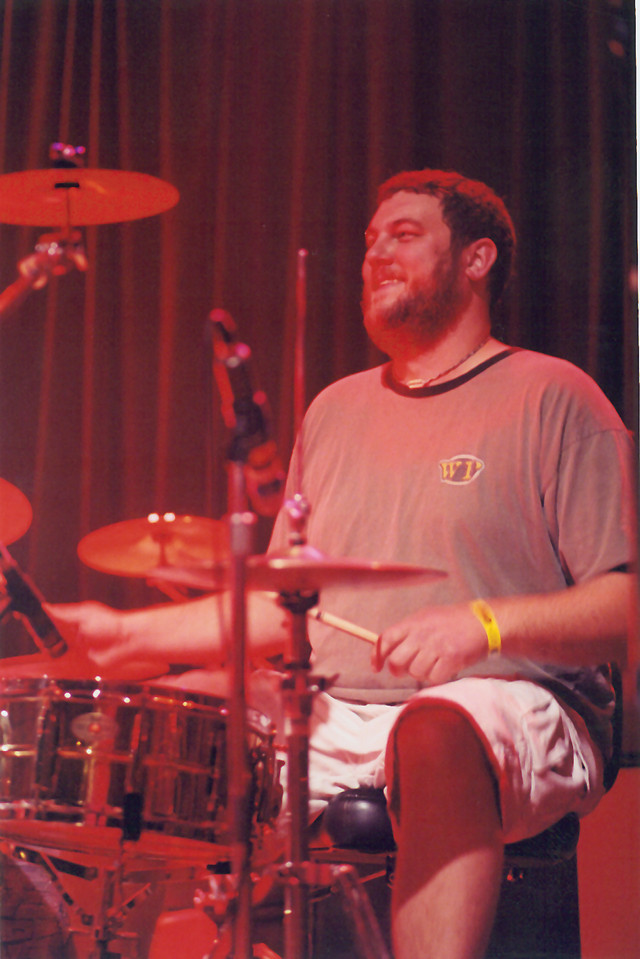
by Nate Burgess Tuesday, May 22, 2018

Todd Hoefen collects ash samples from the Station Fire in Southern California in 2009. Credit: Courtesy of Todd Hoefen
On any given day, you might find Todd Hoefen studying the material properties of other planets, building remote sensing applications, sampling dust from the rubble of natural and human-made disasters, or playing drums with the members of his former rock band, Oakhurst.
Hoefen, a geophysicist at the U.S. Geological Survey (USGS) in Denver, Colo., got his bachelor’s degree in 1996 from Binghamton University, State University of New York, and his master’s degree in environmental science and engineering in 1998 from the Colorado School of Mines in Golden.
Hoefen, only 36, has already had a fascinating career. He was one of several USGS scientists who provided expertise on the characterization of amphibole asbestos from Libby, Mont., for the criminal prosecution U.S. v. W.R. Grace. He was one of the first geoscientists on the scene to study the environmental and health risks of ash and dust after the Sept. 11, 2001, World Trade Center attacks. A couple of years later, he helped assess muds from Hurricane Katrina and ash from California wildfires. Hoefen also discovered olivine on Mars as part of the Mars Global Surveyor (evidence that the red planet had been drier and colder in its past than expected), assisted with the Cassini-VIMS project looking at the moons and rings of Saturn, and has participated in numerous other remote sensing projects.
EARTH’s Nate Burgess recently spoke with Hoefen about his career and adventures.
NB: How did you get involved with such a broad range of science topics?
TH: My career got started with remote sensing and then turned toward both remote sensing and environmental health. As I was finishing my master’s degree at the Colorado School of Mines, a student there told me that Dr. Roger Clark of USGS, who was studying Mars at the time, was looking for some student help. So I applied and in the spring of 1998 started working for USGS as part of the Mars Global Surveyor team, mapping the minerals on Mars using the Mars Global Surveyor Thermal Emissions Spectrometer. For the first two years, that’s all I did.
Around 1999 and into 2000, USGS started working with the Environmental Protection Agency in Libby, Montana, looking at some of their asbestos concerns. Between undergraduate and graduate school, I had worked for an environmental consulting company counting asbestos fibers. As I had some background in asbestos and I had the environmental training, USGS turned to me to do some of this work.
Then the World Trade Center attacks happened. By September 17, 2001, I was at Ground Zero with my USGS colleague Gregg Swayze. We did ground calibration for a remote sensing study by day and dust and debris sampling from the World Trade Center buildings by night. And after this event, I began taking on a role looking at dust and debris material from an environmental and human health perspective. I spearheaded sample collection and processing efforts [at USGS], and at the same time, did some of the more remote sensing work as well, working with Dr. Geoff Plumlee [of USGS], looking at the human health effects of dust and other materials produced by the disaster. This led to work on the Hurricane Katrina aftermath, some volcanoes, and fires in Southern California.
These days, my work is quite diverse. When people ask me what I do, it’s kind of funny describing it, because I was on three projects last year. First was my rapid response to disaster work on our earth materials and human health project. The second project was the hyperspectral surface materials mapping of Afghanistan looking for mineral resources. Third was the Cassini-VIMS project.

Hoefen (right) arrived in New York City with his USGS colleague Gregg Swayze six days after the World Trade Center fell to sample dust from the disaster. Credit: Gregg Swayze, USGS
NB: You’ve done research connected with some of the largest environmental disasters in recent U.S. history. Which of these events affected you the most personally or professionally?
TH: With Katrina, I didn’t actually go into the field, but out of the others, the World Trade Center disaster probably hit home the most for me, being an upstate New Yorker. I had a lot of friends in New York City, and there was so much chaos that was happening between September 11 and September 16 or 17 — which was basically the first flight Gregg Swayze and I could get out of Denver to New York. It was a surreal experience.
The thing I remember the most was the smell of burning metal. It smelled like if you leave an empty pan on high for an hour and then realize you left it there. That’s a smell I’ll always remember. We walked the downtown area collecting ground samples for about 20 hours, one continuous sampling session. We ended the session at Ground Zero, sampling around the debris pile from the World Trade Center buildings. That was definitely one of the most intense things we’ve done.
NB: What was it like playing a scientific role in the midst of that scale of tragedy?
TH: I guess we always knew what we had to do, so we collected all of our samples without trying to think too much about anything else that was going on around us. At the very end, Gregg and I spent our last hour just taking it all in. Seeing pictures of it on the news and in newspapers back home didn’t really compare to what it was like.
NB: How would you compare your early work in environmental consulting to your role at USGS, and how does your work compare to academic research?
TH: Working for an environmental firm is very structured — it is all about collecting a number of samples and then pushing out a number of analyzed samples as fast as you can. At USGS, I really have more of a research role. In Libby, for example, we did research into characterizing the amphiboles. It is similar to an academic role. We still have to publish papers and get funding.
I’ve had the opportunity to see some very interesting places in my career [at USGS], and I have had the freedom and opportunity to work on very exciting research — both planetary and terrestrial. In planetary research, a lot of things are still unknown, so we’ve spent years measuring the spectra of organics from other planets and then freezing them and seeing what their ice properties are. You don’t get a lot of these opportunities in the private contractor setting.

Hoefen works on samples of muds left by flooding from Hurricane Katrina in 2005. Credit: Courtesy of Todd Hoefen
NB: What would you say is your most important scientific discovery so far?
TH: In 2000, while analyzing Thermal Emission Spectrometer data from the Mars Global Surveyor mission, I discovered olivine in the Nili Fossae region of Mars. At least terrestrially, olivine weathers pretty quickly in the presence of water, and you will find all of its alteration products in the area. We were not seeing those alteration products, so I assumed that there hadn’t been much water and that Mars had been drier and colder than we predicted. At the time, I think it was one of the biggest discoveries related to surface mineralogy on Mars.
Now scientists have better instruments, and they are finding some of these alteration products. So at some time in Martian history, water was present. But this layer in which the olivine is present appears to be a unique piece of information from Mars’ past. I wrote a Science paper about it in 2003, and I think today the Nili Fossae region is still proving that it holds many important clues in the evolution of Mars.
NB: I understand that you toured with a band as a drummer. Were you a geophysicist at this point?
TH: Yeah, before college, I told my parents I wasn’t going to college and I was going to move to New York City and be a drummer in a rock and roll band. That didn’t go over too well. [Laughs] So I finished undergraduate and graduate school, and then after I got out of grad school, I formed a band with a couple of other guys. The name of the band is Oakhurst, and they are still around today. I played with them for six years.
I worked for the USGS and worked in a rock and roll band at the same time. It was a challenge at times, but I eventually had to retire from the band.

Hoefen playing drums on tour with the band Oakhurst. Credit: Courtesy of Todd Hoefen
NB: What made you leave the band?
TH: Well, for my career, and because my wife and I had a baby girl named Morhéa about four and a half years ago. The band plays 200-plus gigs a year now, so they are still on the road and doing well. It was a tough choice, but I love my job at USGS and I get the opportunity to do a lot of work that most people don’t get to do. I still visit the boys and jam with them every once in a while. And I have my own creative outlets. The digital era is great for music.
NB: Do you have any advice for up-and-coming geoscientists?
TH: One of the biggest pieces of advice I have is to find a niche in whatever professional setting you end up in. Also, definitely get as much education as you can handle.
© 2008-2021. All rights reserved. Any copying, redistribution or retransmission of any of the contents of this service without the expressed written permission of the American Geosciences Institute is expressly prohibited. Click here for all copyright requests.